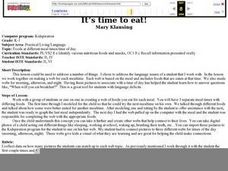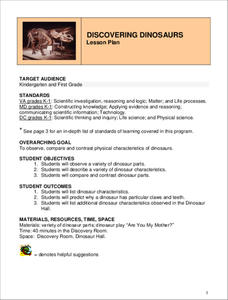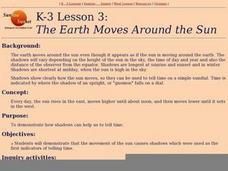Curated OER
Is it a Whale?
Students determine which animals are whales when given pictures of various animals. They give reasons for their decisions..
Curated OER
Ocean Friends Nametags
Students complete a number of activities to complete a study of ocean animals. They identify the animals, make nametags using appropriate colors, the animal habitats, and make a book by putting the pages in numerical order.
Curated OER
Baby Shamu Suit
Students name and describe the functions of the whale body parts. They create killer whale suits out of paper grocery bags, and role-play whale behavior.
Curated OER
On the Road Again
Students trace the migration route of a gray whale. They color and label a map of North America, and using photocopy pictures of a gray whale, they move the whale along the migration route over a ten week period.
Curated OER
Animal Categories
Students sort animal picture cards into classification groups such as mammals, reptiles, amphibians, insects and fish. They discuss the characteristics that each group of animals shares then arrange the pictures into a clasificatioon...
Curated OER
It's Time To Eat!
Students explore the various types of nutritious foods that can be eaten at meal and snack times. they discuss the types of food they eat at mealtimes. Students use Kidspiration to create a web for each mealtime and each snack.
Curated OER
Creepy Crawlers
Students study insects and spiders, and answer questions about the insects they have studied. They complete an insect word search, praying mantis color sheet, and spider and insect Venn diagram. They finish up with a trip to the local...
Curated OER
Animals Are Different
Each animal is different! Showcase animal characteristics through a series of questions based on simple images of well-known animals. This worksheet has learners examining 8 animals: rabbit, penguin, parrot, dolphin, bear, ostrich, duck,...
Curated OER
The ABCs of Conservation
Students identify the letters of the alphabet and corresponding sounds and words that begin with that letter.
Curated OER
Animal Coverings
Students compare and contrast the types of coverings found on animals. They identify a wide variety of animals in a museum room. They classify animals based on their coverings as well.
Curated OER
Discovering Dinosaurs
Students investigate the physical characteristics of dinosaurs. They participate in a puppet show, take a field trip to a dinosaur museum, and compare/contrast dinosaur characteristics at the museum.
Curated OER
Classifying Shells
Students observe and classify different types of shells. They compare and contrast an exhibit they created with one that already exists in a musuem. They discover the different characteristics of shells.
Curated OER
What Is An Insect?
Students find and classify insects. They collect insects, study them with a hand lens and identify its body parts. Afterwards, they discus various types of insects and thier Orders such as beetles, butterflies and moths, grasshoppers, etc.
Curated OER
Palo Verde Identification Key
Students explore a key with characteristics to distinguish between the four Palo Verde trees in Arizona.
Curated OER
Birds, Birds, Birds
Pupils explore one bird a day and eventually put together a book about each of the birds they learn.
Curated OER
Pre-School
Students draw their hand, and color their drawing. They count the number of fingure on thier hand. Students count the number of arms on the marine animal in the picture. They count the number of legs and claws on the marine animal in the...
Curated OER
The Earth Moves Around the Sun
Students demonstrate that the movement of the sun causes shadows which were used as the first indicators of telling time.
Curated OER
Solar Eclipse
Students demonstrate the revolution of the moon around the earth and the effect of its direct alignment in between the earth and the sun.
Curated OER
Planting Wheat with Little Red Hen
Students discuss the cycle of growing wheat, and then plant their own in foil pans. After the wheat grows for a couple of weeks, students participate in a story retelling activity reinforcing the concepts of the process.
Curated OER
Insects Word Wall
In this vocabulary worksheet, students analyze 40 word and picture cards to learn the names of common insects. One set is in color, the other is black and white. These cards are intended to be used on a word wall.
Curated OER
Dinosaur Names Mix And Match
For this vocabulary worksheet, young scholars examine pictures of 16 dinosaurs and learn their names. Students study the word and picture cards. There are no directions but these could be cut apart for a matching game or used on a word...
Curated OER
Scientists Write!
Students use a journal to record observations. They make notes about what research may be needed to answer questions that have come up in the field and sketch or make connections in the curriculum. They research bioinformatics and...
Curated OER
The Five Senses
Pupils participate in a scavenger hunt using their sense of sight. They bring various texture materials from home and discuss how things feel. Students identify the smells inside five jars. They discuss things they hear and why hearing...
Curated OER
Recycle Relay
Here is a quick activity intended to get little learners ready to conserve. They classify trash for recycling by placing items in the categories reduce, recycle and reuse. In teams the sort real life trash items into the best...

























